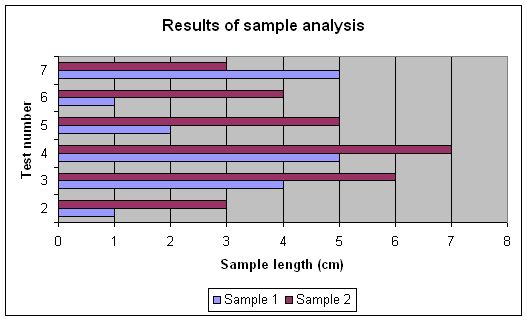NAME
Bar - A writer class for Excel Bar charts.
SYNOPSIS
To create a simple Excel file with a Bar chart using Spreadsheet::WriteExcel:
#!/usr/bin/perl -w
use strict;
use Spreadsheet::WriteExcel;
my $workbook = Spreadsheet::WriteExcel->new( 'chart.xls' );
my $worksheet = $workbook->add_worksheet();
my $chart = $workbook->add_chart( type => 'bar' );
# Configure the chart.
$chart->add_series(
categories => '=Sheet1!$A$2:$A$7',
values => '=Sheet1!$B$2:$B$7',
);
# Add the worksheet data the chart refers to.
my $data = [
[ 'Category', 2, 3, 4, 5, 6, 7 ],
[ 'Value', 1, 4, 5, 2, 1, 5 ],
];
$worksheet->write( 'A1', $data );
__END__DESCRIPTION
This module implements Bar charts for Spreadsheet::WriteExcel. The chart object is created via the Workbook add_chart() method:
my $chart = $workbook->add_chart( type => 'bar' );Once the object is created it can be configured via the following methods that are common to all chart classes:
$chart->add_series();
$chart->set_x_axis();
$chart->set_y_axis();
$chart->set_title();These methods are explained in detail in Spreadsheet::WriteExcel::Chart. Class specific methods or settings, if any, are explained below.
Bar Chart Methods
There aren't currently any bar chart specific methods. See the TODO section of Spreadsheet::WriteExcel::Chart.
EXAMPLE
Here is a complete example that demonstrates most of the available features when creating a chart.
#!/usr/bin/perl -w
use strict;
use Spreadsheet::WriteExcel;
my $workbook = Spreadsheet::WriteExcel->new( 'chart_bar.xls' );
my $worksheet = $workbook->add_worksheet();
my $bold = $workbook->add_format( bold => 1 );
# Add the worksheet data that the charts will refer to.
my $headings = [ 'Number', 'Sample 1', 'Sample 2' ];
my $data = [
[ 2, 3, 4, 5, 6, 7 ],
[ 1, 4, 5, 2, 1, 5 ],
[ 3, 6, 7, 5, 4, 3 ],
];
$worksheet->write( 'A1', $headings, $bold );
$worksheet->write( 'A2', $data );
# Create a new chart object. In this case an embedded chart.
my $chart = $workbook->add_chart( type => 'bar', embedded => 1 );
# Configure the first series. (Sample 1)
$chart->add_series(
name => 'Sample 1',
categories => '=Sheet1!$A$2:$A$7',
values => '=Sheet1!$B$2:$B$7',
);
# Configure the second series. (Sample 2)
$chart->add_series(
name => 'Sample 2',
categories => '=Sheet1!$A$2:$A$7',
values => '=Sheet1!$C$2:$C$7',
);
# Add a chart title and some axis labels.
$chart->set_title ( name => 'Results of sample analysis' );
$chart->set_x_axis( name => 'Test number' );
$chart->set_y_axis( name => 'Sample length (cm)' );
# Insert the chart into the worksheet (with an offset).
$worksheet->insert_chart( 'D2', $chart, 25, 10 );
__END__This will produce a chart that looks like this:

AUTHOR
John McNamara jmcnamara@cpan.org
COPYRIGHT
Copyright MM-MMX, John McNamara.
All Rights Reserved. This module is free software. It may be used, redistributed and/or modified under the same terms as Perl itself.